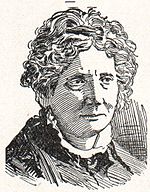the latest telegraphic reports the weather-forecaster is able to predict all large storms with admirable and increasing accuracy. Thus the usual storm-track in the United States is to the east and over the Great Lakes to the Gulf of St. Lawrence. There is a great variety of local storms, as the typhoon of the China Sea and the waters about the Philippine Islands, the windstorms of Arabia, the blizzards or heavy snow-storms accompanied by driving winds, tornadoes etc. The entire subject of storms must, however, be yet considered as an imperfectly understood department of the imperfectly developed but highly important science of meteorology. See Cyclone.
Storrs, Richard Salter, an American
clergyman, was born at Braintree, Mass.,

RICHARD S. STORRS
Aug. 21, 1821. He
studied at Amherst
College and Andover
Theological
Seminary. He was pastor
of the Church of the
Pilgrims, Brooklyn,
N.Y., 1846-99, having
had one of the
longest pastorates
in the city. For a
number of years he
was one of the
editors of The New
York Independent,
and was president
of the American
Board of Missions. He was noted for
his eloquence and beautiful style in the
pulpit and his aptness and readiness in
occasional addresses, and ranked as one
of the first pulpit-orators in America. His
more important publications include a work
on The Divine Origin of Christianity, The
Puritan Spirit, Bernard of Clairvaux and
Forty Years of Pastoral Life. He died on
June 5, 1900.
Sto′ry, Joseph, an American jurist, was born at Marblehead, Mass., Sept. 18, 1779. He was a graduate of Harvard. He was in the legislature in 1805, and in 1808 entered Congress. He was made a judge in the supreme court of the United States in 1811, holding the position for 34 years. In 1829 he became a professor in Harvard Law-School. He was an authority on all legal questions in the United States, his Commentaries on the Constitution of the United States, The Conflict of Laws and Equity Jurisprudence being very valuable. He died at Cambridge, Mass., Sept 10, 1845. See Life by his son.
Story, William Wetmore, American
sculptor and poet, was born at Salem, Mass.,
Feb. 19, 1819, son of Joseph Story, and after
graduating at Harvard studied law and was
admitted to the bar. Among his works as
a lawyer are Reports of Cases, Treatise on
the Law of Contracts, The Law of Sale of
Personal
Property with The Life of Story. In
1848 he abandoned law for sculpture, and

W. W. STORY
to assist him in his
study of fine models
he removed to
Rome, Italy, where
he afterwards
chiefly resided,
until his death at
Vallombrosa on
Oct. 7, 1895. His
allegorical statues
of Cleopatra,
Medea, The African Sibyl
and Semiramis; statues of
George Peabody,
Edward Everett
and Francis Scott
Key; and busts of Lowell, Bryant, Theodore
Parker, Josiah Quincy and his father
represent the bulk of his achievement in
art. In literature he published poems,
essays and rambles in Italy. The chief
of these works which show his culture
and sympathies are Roba di Roma,
Conversations in a Studio, The Castle of St.
Angelo and the Evil Eye, Poems, Excursions
in Art and Letters and A Poet's Portfolio.
He died in 1895.
Stowe, Harriet Beecher, an American
writer, was born at Litchfield, Conn., June

HARRIET BEECHER STOWE
14, 1811. She
belonged to the
celebrated Beecher
family, being the
daughter of Dr.
Lyman Beecher and
the sister of Henry
Ward Beecher. She
was noted as a child
for her fondness for
writing, and at 12
astonished her
teachers with a
composition on the
question: Can the
immortality of the
soul be proved by the
light of nature?
Moving to Cincinnati with her father's
family, she there married Calvin E. Stowe,
then a professor in Lane Theological
Seminary. In that region and through the
servants employed in her own family she
learned much of the evils of slavery. Her
husband's connection with many prominent
abolitionists; his knowledge of the workings
of “the underground railroad;” a
pro-slavery riot in the city, when many of the
intended victims were concealed and fed
by herself and her friends; a sojourn of a
brother in the south; and his observations
on the slave-trade all helped to fit her for
her work. Her first published volume was
made up of sketches written for the papers
and periodicals of the day, and was called
